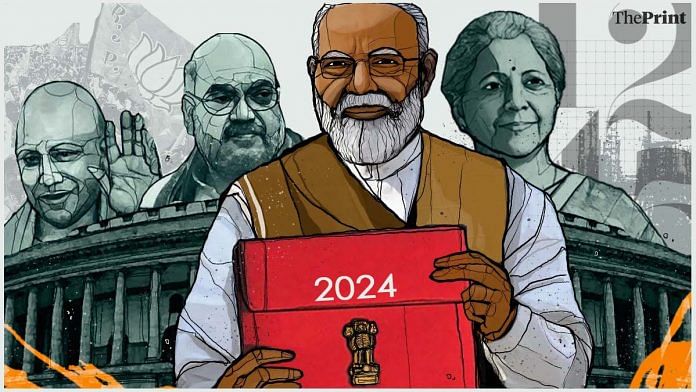A finance minister presenting the Budget on the eve of a major election braces herself for that familiar charge: This is an election Budget. How does Nirmala Sitharaman’s latest Budget answer that question? Let’s steal the answer from Sir Humphrey’s playbook: It is an election Budget and it isn’t. It depends on your perspective.
This is not an election Budget in the sense that I might target the voter in the coming elections. No large yojanas or giveaways for farmers (western Uttar Pradesh, Punjab), no increase in direct benefit transfers or other relief payouts, and definitely nothing by way of tax breaks or exemptions that the middle class loves.
But, if you look beyond this round of state elections that begin in less than a fortnight now, and tilt the periscope to gaze at the more distant horizon, see how the Modi government wishes for things to look by the summer of 2024, still two and a half years away?
It would want growth maintaining at least a 7 per cent-plus clip, generating jobs, lifting the current economic malaise. That’s why the massive rise in borrowings, emphasis on capital expenditure to build both hard, physical infrastructure, notably highways and rural roads, and soft ones like optical fibre connectivity in rural areas.
Also Read: It isn’t the economy, genius. India proves it by voting for Modi again and again
Economists read wisdom from data. We search for political messaging. Early on with the rise of the Modi phenomenon, we had said that it rests on three pillars. One, hard, Hinduised nationalism. Second, efficient and leak-proof delivery of direct benefits to the poorest, and third, the building of hard, visible infrastructure. The fact is, well into its eighth year now, the most visible infra showpieces the Modi government has built are the highways and now expressways.
How important these are to Modi politically and electorally? You can figure from his prolific landings in IAF aircraft on these in poll-bound states. Expressways are now the centrepiece of his Uttar Pradesh campaign. That’s why a lot more money is going in that direction. The third pillar of Modi’s electoral proposition is being concretised further. The first two, he manages with direct political messaging and delivery.
Rahul Gandhi and other critics are absolutely right to say that the Budget has nothing for the salaried and middle classes. The message is again a familiar one, if only the critics would accept that harsh reality once. The Hindu middle class, from traders to the self-employed and definitely the salaried, are the largest committed vote bank for Narendra Modi. He needs to do nothing to ‘buy’ their votes. He’s their default choice.
That’s why when we said that the middle class was the Modi-Shah BJP’s Muslims, we didn’t mean any offence to the Hindu middle class or the Muslims. It was political plain speak. Just as Muslims vote for any ‘secular’ force they think might be able to keep the BJP restrained, the middle class now votes for the BJP-Modi Hindutva to keep the secular (‘pro-Muslim’) forces out. The middle classes, especially the salaried groups, have voluntarily excluded themselves from any Budget goodies. Their concerns are no longer just material.
We must also acknowledge a certain middle class approach this government takes to managing the economy. Of course, no finance minister can follow all our mothers’ cardinal principle for running the household: Either spend less than you earn, or earn more than you spend. The most powerful economies run on deficit.
To begin with, Sitharaman’s tax collections under all categories have exceeded estimates by some impressive distance. This includes corporate taxes where rates were reduced, drawing expected criticism of handouts for rich corporates. Evidence again, though it would never convince non-believers, that moderate rates bring better compliance.
There’s been much well-meaning but bad advice floating in the pandemic air. Tax the rich more heavily, tax inheritance of their children, tax their tax-paid wealth yet again, and tax them maybe for the size of windows in their homes and of course, the number and pedigree of pets they keep. Must invent super taxes for the super-rich. These ideas are economically ruinous but politically tempting. It’s a safe presumption that anything that seems to crush the toes of the rich pleases the poor. The finance minister deserves appreciation for tossing these out.
It is often said that strongmen and populist leaders read from the same playbook. Narendra Modi’s actions might conform to some of those, but they don’t conform to fiscal profligacy and monetary arrogance. For example, Turkey’s Erdogan. Fiscal deficit, inflation have been moderate, exchange and interest rates (monetary policy) are not influenced beyond a threshold, and the irresistible tax-and-spend temptation is firmly resisted. We know how tax-and-spend almost always ends up as tax-and-spray. Any year is an election year in India.
The message for our political economy is, this is still a fiscally responsible government playing the long game. Not tax-and-spray, but borrow-and-invest. It expects growth translating into votes in 2024 to be the return on that investment. To that extent, it is reasonable politics. It is an election Budget if your perspective is 2024, not 2022.
Also Read: Economic ideology is the new binary in Indian politics as Modi swerves Right & Rahul Left






